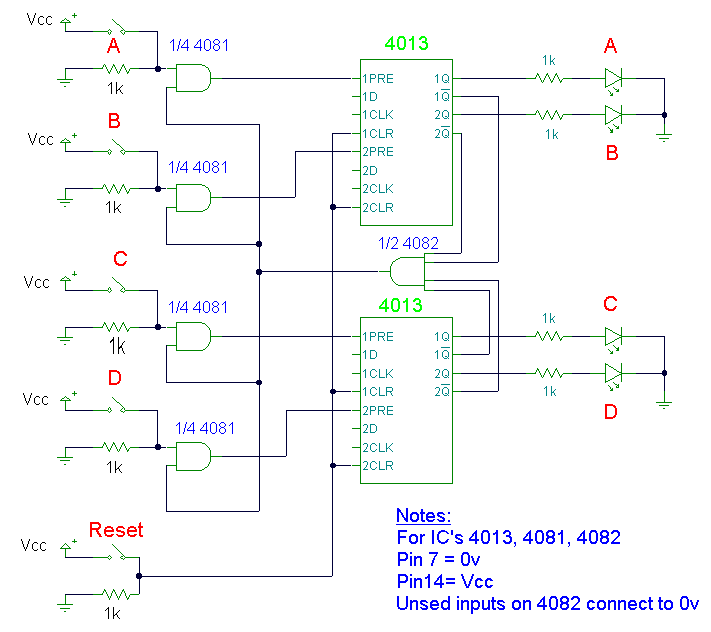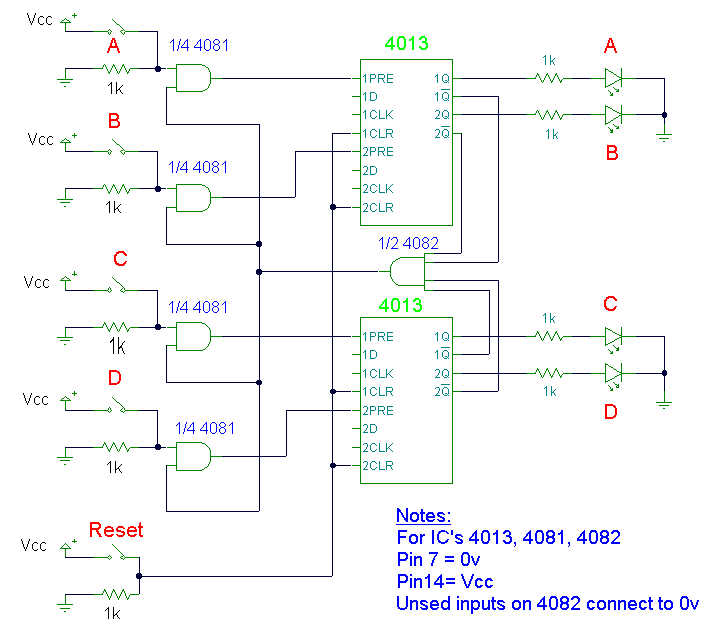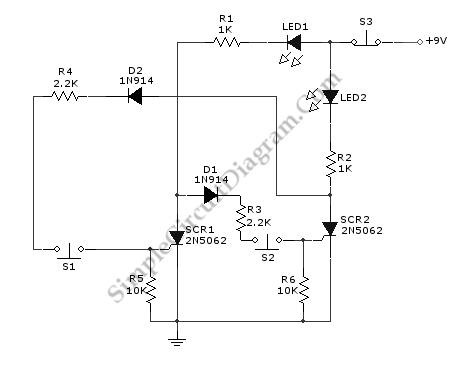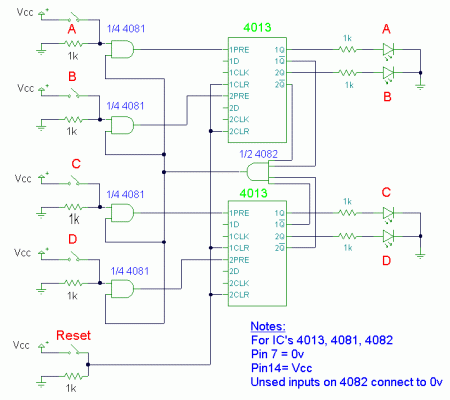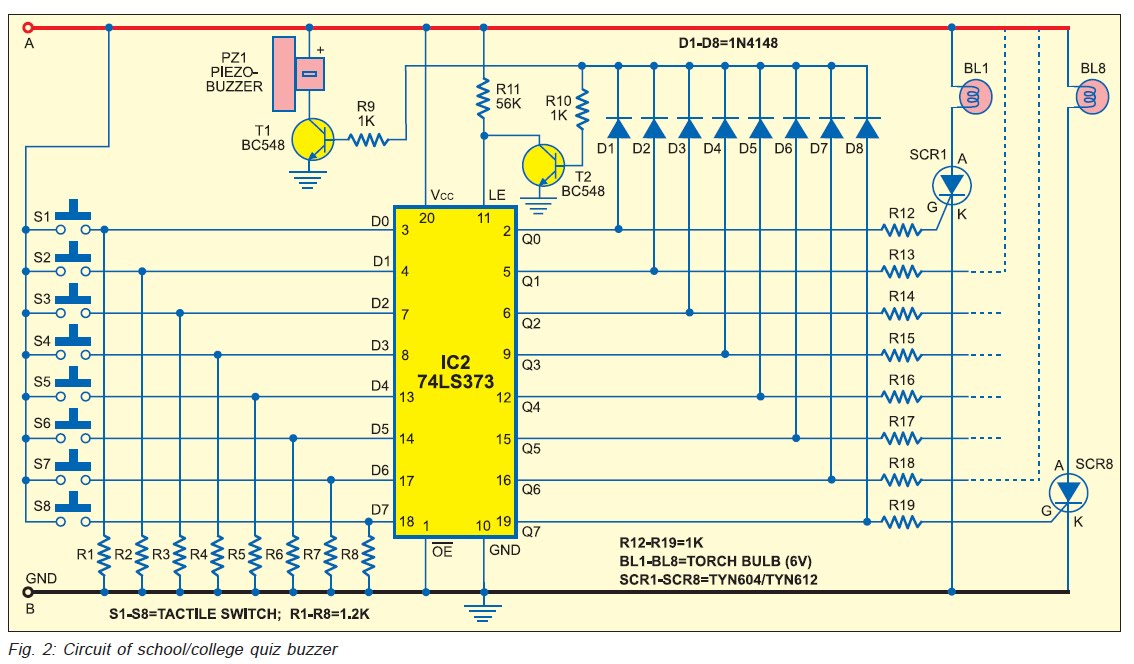
Fastest Quiz Bell/Alarm
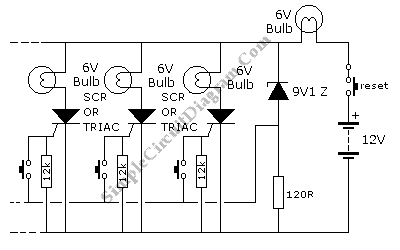
This is a quiz bell/alarm circuit designed to indicate the fastest finger first. The circuit includes one bulb for the quiz master and one for each contestant. The bulbs illuminate when a button is pressed. The cathode of the 9V Zener diode experiences approximately mid-rail voltage, also illuminating the quiz master bulb. No other bulbs can be lit until the circuit is reset because the Zener diode ceases conduction, resulting in no voltage across the 120Ω resistor. The reset switch must be a normally closed push button to disconnect the power supply while pressed. A pair of cross-coupled SCRs can be utilized to construct a first-response monitor circuit, as depicted in the schematic diagram below. This first-response circuit is popular in quiz applications where the first contestant to press the button prevents others from responding. This is a switching circuit that provides a latching mechanism to create a set of radio buttons using push buttons. The circuit consists of an interlocking design that manipulates the signal to latch and release the previously latched section. The schematic also illustrates a Zener regulator. The essential component is the dropping resistor R, which is calculated using the formula (V - Vo)/I, where I is the desired output plus 10%. As long as the supply voltage V remains constant, the circuit operates effectively. Additionally, this is a small audio amplifier circuit, similar to those used in small transistor radios, which draws about 30 milliamps from a 9-volt supply. This circuit consists of two stages. WARNING: Do not touch any part of the circuit when it is operational (connected to the power line), as this circuit is not isolated from the mains supply. This is a transformerless power supply circuit used to generate a fixed voltage power output.
The quiz bell/alarm circuit operates by utilizing a combination of bulbs and a button mechanism to indicate which contestant has pressed their button first. The circuit is designed with a 9V Zener diode that regulates the voltage to ensure stable operation. When a contestant presses their button, the associated bulb lights up, signaling their response. The quiz master’s bulb also illuminates, indicating that the quiz master is aware of the response.
The reset mechanism is critical for ensuring that only the first contestant's response is acknowledged. By employing a normally closed push button as the reset switch, the circuit is designed to disconnect the power supply while the button is pressed, effectively resetting the system for the next question. The use of cross-coupled SCRs allows for a robust first-response monitoring system, ensuring that once a contestant has pressed their button, the circuit prevents others from activating their bulbs until reset.
The interlocking circuit design enables a latching mechanism that can manage multiple push buttons. This feature is beneficial in quiz scenarios, as it allows for a clear indication of the first response while preventing confusion among contestants. The Zener regulator ensures that voltage levels remain within acceptable limits, enhancing the reliability of the circuit.
Furthermore, the audio amplifier stage of the circuit serves to amplify any audio signals that may be generated, providing clear sound output for the quiz master or audience. It operates efficiently with a low current draw of approximately 30 milliamps from a 9-volt supply, making it suitable for compact applications.
Safety precautions are emphasized, particularly regarding the transformerless power supply. Users are advised against touching the circuit while it is powered to prevent electric shock, as it lacks isolation from the mains supply. Overall, this quiz bell/alarm circuit exemplifies an efficient and effective design for interactive quiz applications, incorporating essential electronic components to deliver reliable performance and safety.This is aquiz bell/alarm circuit. This circuit indicate fastest finger first . This circuit has one bulb for Quiz master and one for each contestant. The bulb will illuminate when a button is pressed. the cathode of the 9v1 zener sees approx mid-rail voltage. The Quiz Master bulb is also illuminated. Here is the circuit: There is no other bulbs can be lit until the circuit is reset because The zener comes out of conduction and no voltage appears across the 120R resistor. The reset switch must be a normally closed push button, to disconnect the power supply when it`s being pressed.
A pair of cross-coupled SCRs can be used to build a first-response monitor circuit, as shown in the schematic diagram below. First-response circuit is popular in quiz application where the first contestant who press the button will prevent the other Continue reading †’.
This is a switching circuit that provide latching mechanism to make a set of radio buttons using push buttons. This circuit consist of interlocking circuit that manipulate the signal to latch and release the previous latched section.
The circuit latches Continue reading †’. The figure below show us a zener regulator. The essential component is the dropping resistor R which the value given by (V-Vo)/I, where I is the desired output plus 10%. As long as the supply voltage V is constant, the Continue reading †’. This is a little audio amplifier, it is similar to the audio amplifier which is used in small transistor radio.
This circuit draws about 30 milliamps from a 9 volt supply. This circuit consist of two stage. First stage is Continue reading †’. WARNING: Don`t touch any part of the circuit when the circuit is running (connected to the powerline), this circuit is not isolated from mains supply. This is transformerless power supply circuit. This circuit is used to generate fixed voltage power Continue reading †’. 🔗 External reference
The quiz bell/alarm circuit operates by utilizing a combination of bulbs and a button mechanism to indicate which contestant has pressed their button first. The circuit is designed with a 9V Zener diode that regulates the voltage to ensure stable operation. When a contestant presses their button, the associated bulb lights up, signaling their response. The quiz master’s bulb also illuminates, indicating that the quiz master is aware of the response.
The reset mechanism is critical for ensuring that only the first contestant's response is acknowledged. By employing a normally closed push button as the reset switch, the circuit is designed to disconnect the power supply while the button is pressed, effectively resetting the system for the next question. The use of cross-coupled SCRs allows for a robust first-response monitoring system, ensuring that once a contestant has pressed their button, the circuit prevents others from activating their bulbs until reset.
The interlocking circuit design enables a latching mechanism that can manage multiple push buttons. This feature is beneficial in quiz scenarios, as it allows for a clear indication of the first response while preventing confusion among contestants. The Zener regulator ensures that voltage levels remain within acceptable limits, enhancing the reliability of the circuit.
Furthermore, the audio amplifier stage of the circuit serves to amplify any audio signals that may be generated, providing clear sound output for the quiz master or audience. It operates efficiently with a low current draw of approximately 30 milliamps from a 9-volt supply, making it suitable for compact applications.
Safety precautions are emphasized, particularly regarding the transformerless power supply. Users are advised against touching the circuit while it is powered to prevent electric shock, as it lacks isolation from the mains supply. Overall, this quiz bell/alarm circuit exemplifies an efficient and effective design for interactive quiz applications, incorporating essential electronic components to deliver reliable performance and safety.This is aquiz bell/alarm circuit. This circuit indicate fastest finger first . This circuit has one bulb for Quiz master and one for each contestant. The bulb will illuminate when a button is pressed. the cathode of the 9v1 zener sees approx mid-rail voltage. The Quiz Master bulb is also illuminated. Here is the circuit: There is no other bulbs can be lit until the circuit is reset because The zener comes out of conduction and no voltage appears across the 120R resistor. The reset switch must be a normally closed push button, to disconnect the power supply when it`s being pressed.
A pair of cross-coupled SCRs can be used to build a first-response monitor circuit, as shown in the schematic diagram below. First-response circuit is popular in quiz application where the first contestant who press the button will prevent the other Continue reading †’.
This is a switching circuit that provide latching mechanism to make a set of radio buttons using push buttons. This circuit consist of interlocking circuit that manipulate the signal to latch and release the previous latched section.
The circuit latches Continue reading †’. The figure below show us a zener regulator. The essential component is the dropping resistor R which the value given by (V-Vo)/I, where I is the desired output plus 10%. As long as the supply voltage V is constant, the Continue reading †’. This is a little audio amplifier, it is similar to the audio amplifier which is used in small transistor radio.
This circuit draws about 30 milliamps from a 9 volt supply. This circuit consist of two stage. First stage is Continue reading †’. WARNING: Don`t touch any part of the circuit when the circuit is running (connected to the powerline), this circuit is not isolated from mains supply. This is transformerless power supply circuit. This circuit is used to generate fixed voltage power Continue reading †’. 🔗 External reference
Warning: include(partials/cookie-banner.php): Failed to open stream: Permission denied in /var/www/html/nextgr/view-circuit.php on line 713
Warning: include(): Failed opening 'partials/cookie-banner.php' for inclusion (include_path='.:/usr/share/php') in /var/www/html/nextgr/view-circuit.php on line 713
